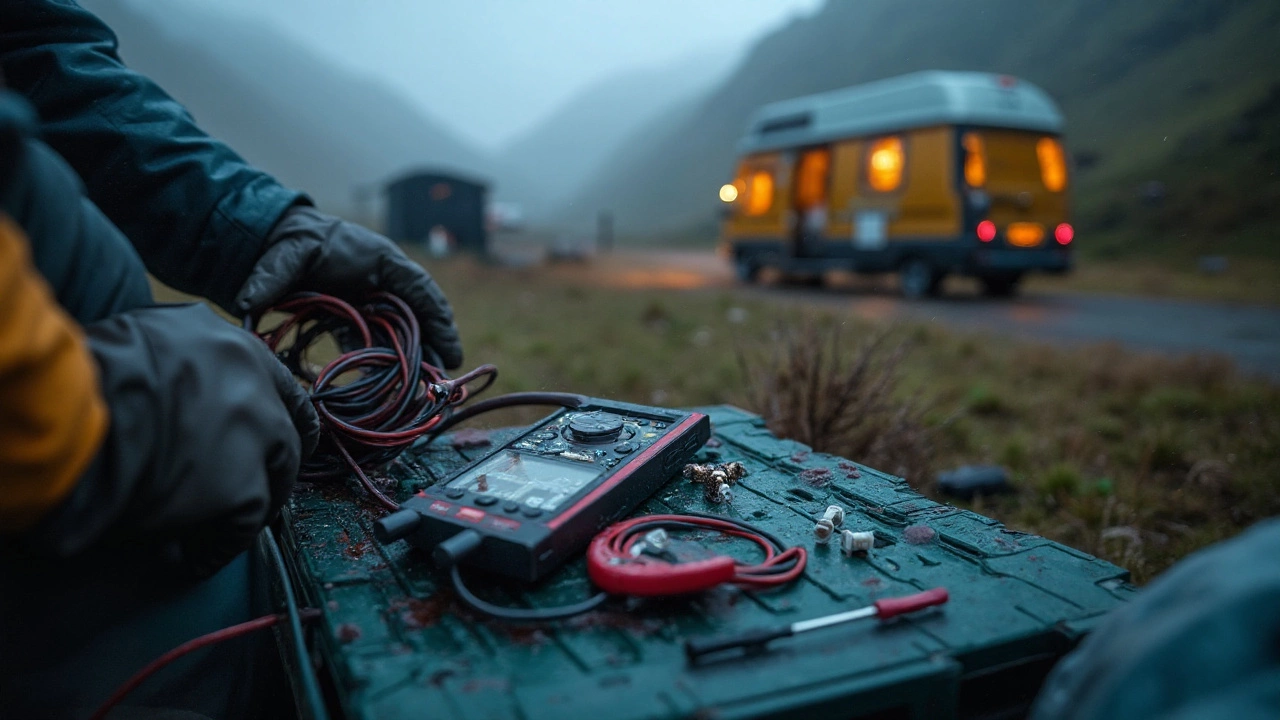How to Get Electricity While Camping (2025): Solar, Batteries, Generators
 Sep, 16 2025
Sep, 16 2025
You want cold food, charged phones, maybe a coffee machine… without dragging your house to the bush. Yes, you can have reliable electricity while camping, but not every setup can run everything. If you size your system right, pick the right gear, and keep it safe, you can power lights, fridges, cameras, and laptops day after day-quietly and legally, even under WA fire bans.
This guide gives you clear steps, honest limits, real Australia-first numbers, and field-tested setups that actually work. I camp across WA, from Yalgorup to Karijini, and the same rules keep popping up: know your daily energy, recharge faster than you burn it, and don’t fight physics with wishful thinking.
TL;DR: the quick answer for camping electricity
- Start with your daily energy budget: add up device watt-hours (Wh) and add 20-30% buffer.
- Pick storage to match 1-2 days of use (AGM: 50% usable; LiFePO4: 80-90%). Recharge with solar, alternator, mains, or a small generator.
- Use 12V DC where you can (fridges, lights) and only invert to 240V for short, high loads (coffee machine, laptop).
- In WA sun: 200W solar gives ~700-900 Wh/day in good weather. Driving 2 hours with a 25A DC-DC charger adds ~600 Wh.
- Safety beats convenience: fuse every positive off the battery, keep generators outside, and use RCDs with 240V.
Step-by-step: plan your power (loads, capacity, and setup)
If you skip this bit, everything else is guesswork. Five minutes of maths saves you hundreds of dollars and a warm fridge.
- List your devices and hours. Write the power (W) and time you’ll use each device per day. If you only know amps (A) at 12V, power (W) ≈ A × 12.
- Convert to energy. Energy (Wh) = Watts × hours. Example: 50W fridge averaging 20 hours/day cycling ≈ 1,000 Wh/day; laptop 60W × 2h = 120 Wh.
- Add a buffer. Add 20-30% for inverter losses, cloudy days, and kids charging tablets.
- Size your battery. Work in watt-hours: 100Ah AGM ≈ 1,200 Wh but only ~600 Wh usable; 100Ah LiFePO4 ≈ 1,200 Wh with ~1,000 Wh usable. Aim for 1-2 days of autonomy.
- Plan your recharge. Decide your mix: solar (silent), alternator/DC-DC (while driving), mains (when on powered sites), or generator (backup or high-wattage tools).
- Choose outputs. Prefer 12V for fridges/lights. Invert to 240V only when needed. Pure sine inverters protect sensitive gear; 300-600W handles most camp needs.
- Safety plan. Fuse every battery positive close to the battery (as close as practical), use correct cable thickness, weatherproof your connectors, and keep charging gear ventilated.
Handy conversions:
- Wh to Ah at 12V: Ah ≈ Wh ÷ 12. Example: 600 Wh ≈ 50 Ah from the battery.
- mAh (power banks) to Wh: Wh ≈ (mAh ÷ 1,000) × 3.7. Example: 20,000 mAh ≈ 74 Wh.
- Solar harvest: Daily Wh ≈ panel watts × peak sun hours × 0.6-0.75 (losses, angle, temp).
Perth gets around 5.5 peak sun hours on average over the year (Bureau of Meteorology solar exposure maps), more in summer, less in winter. A 200W panel can net ~700-900 Wh on a good day if angled and not shaded.

Choosing your power source: solar, battery, generator, or hookup
Different trips, different tools. Mix and match to suit how you camp.
- Mains hookup (powered sites): The easiest. Use a 15A orange caravan lead and an RCD. If you must connect to a 10A domestic outlet (e.g., at home), use a certified 15A-to-10A adaptor with built-in RCD and overload protection. Australian Standard AS/NZS 3001:2022 sets the rules for recreational vehicle electrical installs.
- Solar panels: Rigid on the roof for touring, foldable or blankets for base camps. MPPT controllers squeeze 10-25% more than PWM. Tilt towards the sun; avoid shade-even a hand-sized shadow can cut output by half.
- 12V dual-battery with DC-DC charging: Best for regular driving between camps. A 25-40A DC-DC charger is typical in 4WDs; at 25A you’ll add ~300W while moving. Use LiFePO4 storage if you can-it’s lighter, lasts longer, and charges faster.
- All-in-one power stations: Fast to deploy, zero wiring, built-in inverter and MPPT in many models. Great for tents and weekenders. Size by watt-hours, not marketing names.
- Generators: Quiet inverter generators (1-2 kVA) run kettles, air pumps, and big battery chargers. Check park rules and fire bans (DFES in WA). Place downwind, 6+ metres from sleeping areas, and never indoors-carbon monoxide kills.
Quick comparison (Australia, 2025 ballparks):
| Option | Best for | Pros | Cons | Typical cost (AUD) | Weight | Noise |
|---|---|---|---|---|---|---|
| Mains hookup | Caravan parks | Unlimited power, simple | Not off-grid | $80-$200 for safe leads/RCD | Low | Silent |
| Solar + battery | Quiet off-grid stays | Silent, low running cost | Weather dependent, bulkier | $400-$2,500+ | Medium | Silent |
| 12V dual-battery (DC-DC) | Road trips with daily driving | Charges while you drive | Install cost, wiring skill | $800-$2,000 installed | Medium | Silent |
| All-in-one power station | Tents, simple setups | Plug-and-play, compact | Price per Wh higher | $300-$2,000+ | Low-Medium | Silent |
| Generator (inverter type) | High-wattage tools, backup | Runs big AC loads | Noise, fuel, bans apply | $500-$1,800+ | Medium | 50-60 dB@7m |
Notes: Prices/weights vary by brand. For standards and safety, check Clean Energy Council guidance, AS/NZS 3001:2022 for RV electricals, and WA’s Department of Fire and Emergency Services for generator/fire-ban rules.
Real-world setups and wiring: examples, tables, and checklists
Use these scenarios to copy/paste into your own plan.
1) Weekend tent, no fridge
- Loads: 2 phones (2 × 12 Wh), headlamps (2 × 4 Wh), camp lights (20 W × 4h = 80 Wh), camera (15 Wh). Total ≈ 127 Wh/day.
- Storage: 300-500 Wh power station or 12V 40Ah LiFePO4 with 12V outputs.
- Recharge: 100W solar blanket (≈ 350-450 Wh on a good day) or charge at home then top up with 12V from the car while driving.
- Inverter: 150-300W pure sine for laptop/coffee grinder.
2) Family car camping with a 50L fridge
- Loads: 50L fridge (~35 Ah/day at 12V ≈ 420 Wh), lights 80 Wh, laptop 120 Wh, phones 24 Wh. Total ≈ 644 Wh/day.
- Storage: ~1,200 Wh usable (e.g., 100Ah LiFePO4). That’s ~1.5-2 days without recharge.
- Recharge: 200W solar (≈ 700-900 Wh/day) keeps up in decent weather; add 25A DC-DC from alternator if you drive most days.
- Wiring: 6mm² cable to fridge circuit, 30A fuse near the battery, Anderson plug for detachable connections.
3) 4WD touring, two fridges + cameras
- Loads: Two fridges ~800-1,000 Wh/day total, plus charging ~200 Wh. Total ≈ 1,200 Wh/day.
- Storage: 2,000 Wh usable (e.g., 170Ah LiFePO4) for headroom.
- Recharge: 40A DC-DC (≈ 500 Wh per hour of driving) + 300-400W solar for camp days.
- Wiring: 16mm² from battery to a fused distribution block; individual circuits fused to device ratings. Keep high-current runs under 3 m; voltage drop under 3%.
4) Off-grid caravan (unpowered site)
- Loads: 95L fridge, lights, water pump, TV, laptops: 1,200-1,800 Wh/day.
- Storage: 200-300Ah LiFePO4 (2,400-3,600 Wh usable).
- Recharge: 400-600W roof solar + 30-50A DC-DC while towing. Keep a small inverter generator as a cloudy-week backup for the onboard charger.
- Compliance: RV installs must meet AS/NZS 3001:2022. Use compliant RCDs and proper earth bonding as per the standard.
Typical device draws (realistic, not brochure-perfect):
| Device | Power (W) | Daily use | Daily energy (Wh) | Notes |
|---|---|---|---|---|
| LED strip light | 5-10 | 4-6 h | 20-60 | Use warm white for bugs |
| Phone charge | 10-18 | 1-2 h | 12-36 | Charge midday when solar is strong |
| Laptop | 45-90 | 1-3 h | 45-270 | Use DC car charger to skip inverter losses |
| Drone battery | 60-90 | 1 battery | 40-70 | Fast chargers spike higher |
| 12V 50L fridge | 4-6A @12V avg | 24 h cycling | 350-600 | Hot days = higher. Ventilate the compressor. |
| Espresso machine | 900-1,500 | 6-10 min | 100-200 | Short but high surge-watch inverter size |
| Induction cooktop (low) | 600-1,200 | 10-20 min | 100-400 | Better on generator or gas |
Wiring basics that keep you out of trouble:
- Fuse the main battery positive (e.g., 50-100A depending on system) as close to the battery as you can.
- Pick cable size to keep voltage drop under 3% on 12V runs. Rule of thumb: 6mm² for up to ~40A over short runs; 10mm² or more for higher loads/longer runs.
- Use Anderson plugs for high-current connections; cigarette sockets are fine for small loads but get hot above ~10A.
- Mount controllers and batteries where they get airflow. Heat kills performance.
- Label everything. In the dark, you’ll thank yourself.
Packing checklists:
- Power basics: battery/power station, solar (panel + controller), leads (Anderson, USB-C PD, 12V), RCD lead for mains, spare fuses, multimeter, tape, zip ties.
- Protection: cable glands, IP-rated junctions, shade cloth for panels, fridge cover, fire extinguisher rated for electrical fires.
- Spare bits: spare USB cables, 12V fuse kit, Anderson housings/pins, ring terminals, heat shrink, small toolkit, nitrile gloves.
Australia-specific rules and etiquette:
- Generators: Many national parks restrict hours or ban them; check the park notes. Fire bans may also restrict use (DFES publishes current alerts).
- 240V: Use RCD protection and compliant leads. For RV installs, the relevant standard is AS/NZS 3001:2022.
- Solar: Secure panels in wind; blankets can kite away fast on the coast. Don’t block tracks or footpaths.

Mini-FAQ and troubleshooting: fix common camping power issues
Quick answers to the stuff people ask me most.
- Can I run a heater or kettle off batteries? Short answer: not well. A 2,000W kettle will empty a 1,000 Wh battery in under 30 minutes of boil time. Use gas or a generator for high-heat loads.
- How long will a 100Ah battery run my fridge? If it’s LiFePO4 (≈1,000 Wh usable) and your fridge needs ~500 Wh/day, you’ll get roughly two days without recharge. AGM at 100Ah gives ~600 Wh usable-closer to one day.
- Do I need a pure sine inverter? If you’ll run laptops, camera chargers, or anything with an AC motor/electronics, yes. Modified sine can buzz, overheat gear, or fail to start it.
- Is LiFePO4 safe? Yes, safer than older lithium chemistries and lighter than AGM. Keep it within its rated charge temps, secure it, and use a BMS-managed pack from a reputable maker.
- What size solar for winter in the South West? Plan ~3-4 peak sun hours. A 200W array could net 360-600 Wh. If your daily use is ~700 Wh, go to 300-400W or add alternator/occasional mains.
- Can I charge while driving? With a DC-DC charger, yes-25-40A is common in 4WDs. Some power stations accept car charging at 8-12A; check the spec sheet.
- What’s better: separate components or an all-in-one? If you like plug-and-play, a portable power station is brilliant. If you want max efficiency, custom wiring, and easy upgrades, go separate.
Troubleshooting playbook:
- Solar isn’t keeping up: Clean panels, tilt to sun, eliminate shade, shorten cables, switch to MPPT if you’re on PWM, add 100-200W more panel, or reduce loads midday.
- Fridge warm and battery tanking: Improve ventilation, pre-chill at home, keep food mass high, shade the fridge, drop setpoint a touch (3-4°C), and use a dedicated thick cable run.
- Inverter trips or beeps: You’re exceeding surge or the battery voltage is low. Start high-draw devices one at a time. If running coffee or induction, consider a generator or a larger inverter/battery.
- RCD keeps tripping on mains: Suspect a dodgy lead or water ingress. Dry gear, test with a different lead, and don’t bypass safety devices.
- Generator upsets the neighbours: Use eco mode, place it behind a windbreak, run it mid-day only, and post a note if you’re charging after cloudy days. Follow park hours.
Next steps by camper type:
- Tenter, no fridge: 300-500 Wh storage + 100W solar. Add a small pure sine inverter and USB-C PD charger. You’re done.
- Car camper with fridge: 1,000-1,500 Wh storage + 200-300W solar + 25A DC-DC. Wire with 6-10mm², fuse properly.
- 4WD tourer: 1,500-2,500 Wh storage, 300-400W solar, 40A DC-DC, distribution block, Anderson everywhere.
- Caravan: 200-300Ah LiFePO4, 400-600W solar, 30-50A DC-DC, compliant mains with RCD, and a 1-2 kVA generator for backup.
Why trust these numbers? They line up with Australian conditions (Bureau of Meteorology solar data), standard RV electrical practice (AS/NZS 3001:2022), and on-the-ground experience. The Clean Energy Council also backs the MPPT/tilt/shading advice. Check WA DFES for current fire-ban and generator rules before you go.